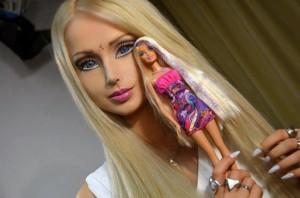
Valeria Lukyanova has undergone several plastic surgeries and follows an extreme diet in order to have looks similar to that of a Barbie doll.
“What is art? What makes it good or bad, and who decides?”
I was re-watching the film “Mona Lisa Smile” when I considered the broader implications of Professor Katherine Watson’s questions. These were questions that, arguably, could relate as much to the subject of beauty as to that of art.
What is beauty? What makes it good or bad, and who decides?
I think it would be fair to say that we all generally agree there is no singular definition of beauty — no one person embodies all the characteristics of a perfectly beautiful woman in the eyes of every human.
Yet, while we all know that beauty comes in many forms, most of us still believe that beauty is not natural, and must be worked for. In fact, the common understanding is that beauty is pain, and if we are not pained, then we must not be beautiful.
There are the classic beauty credentials: Flawless skin; straight, pearly white teeth; shiny hair; long lashes; tiny waist; and long, lean legs.
We have been conditioned to believe that we must constantly strive to perfect ourselves by getting closer to achieving these definitions of beauty, to identify every potential flaw and correct it so we can come closer to becoming “our most beautiful selves.”
They call her the real-life Barbie doll, but the Ukranian model’s real name is Valeria Lukyanova.
Michael Idov, who interviewed her for GQ Magazine commented, “Her beauty, though I hesitate to use the term, is pitched at the exact precipice where the male gaze curdles in on itself. Her features are the features we men playfully ascribe to ideal women; it’s how we draw them in manga and comics and video games. Except we don’t expect them to comply with this oppressive fantasy so fully. As a result, she almost throws our idea of a supervixen back in our face.”
As I read this, I couldn’t decide if I wanted to laugh or cry. I can’t help but find amusement in the ridiculous expectations bestowed upon women by some men, coupled with the fact that some people’s vision of beauty couldn’t be further from the truth; yet at the same time, I am devastated by the reminder that so many of us still fixate on how women should look, rather than embrace femininity in all its forms.
Granted, both men and women are guilty of feeding this image bestowed upon the “idealistic” woman. We are all responsible for the continual destruction of one’s own body image. It never seems to be acceptable to feel comfortable and confident in your own skin, and the society we live in seems to encourage the idea that you must never accept the body you were born in, but rather strive to mold to an abstract perception of true beauty.
As I was reading the interview, I came across the interviewer’s description of his “dinner date” with the human Barbie at Kamasutra, an Indian restaurant: “there are the usual three chutneys on the table — mint, tamarind and chile. Valeria gets a carrot juice, then proceeds to upend all three chutneys into it, swirl the result with her straw, and drink. This gag-inducing mix, she explains, is her dinner; she is on an all-liquid diet these days.”
That’s what I mean. Obviously Valeria feels the need to achieve the perfect feminine body by starving herself, and the worst part is, she thinks this is the best way to become the woman she aspires to be. But I have to wonder if she always viewed beauty this way — what changed her mind and distorted her understanding of femininity?
Though most of us won’t invest our life savings into surgically transforming ourselves into doll-like figures, we have been conditioned to associate feminine beauty with Barbie-like qualities.
In response to the public’s reaction to her physical transformation, Valeria said, “Even though people call me a Barbie, I never tried to look like a doll. I just like everything beautiful, feminine and refined.”
While this may all sound perfectly reasonable, it is that Valeria then follows up by adding “It just so happens that dolls are based on the image of refined girls,” that shows this perhaps is not a healthy ideal.
While Valeria has the right to run her own life, her choices should serve as a warning — teach girls to shrink themselves, and they will; teach girls to feel constant dissatisfaction with their bodies, and they will make every effort to perfect themselves; teach girls that beauty is pain, and they will suffer through the better part of their lives until they either admit defeat and fully lose the ability to determine their own self-worth, or until they self-destruct.
Someone once said, beauty is in the eye of the beholder. It is about time that we put a cap on society’s influence over our perceptions of beauty, and instead, adopted that role for ourselves.
Daria Etezadi is a rising sophomore in the School of Foreign Service. Made From Scratch appears every other Monday at thehoya.com.













